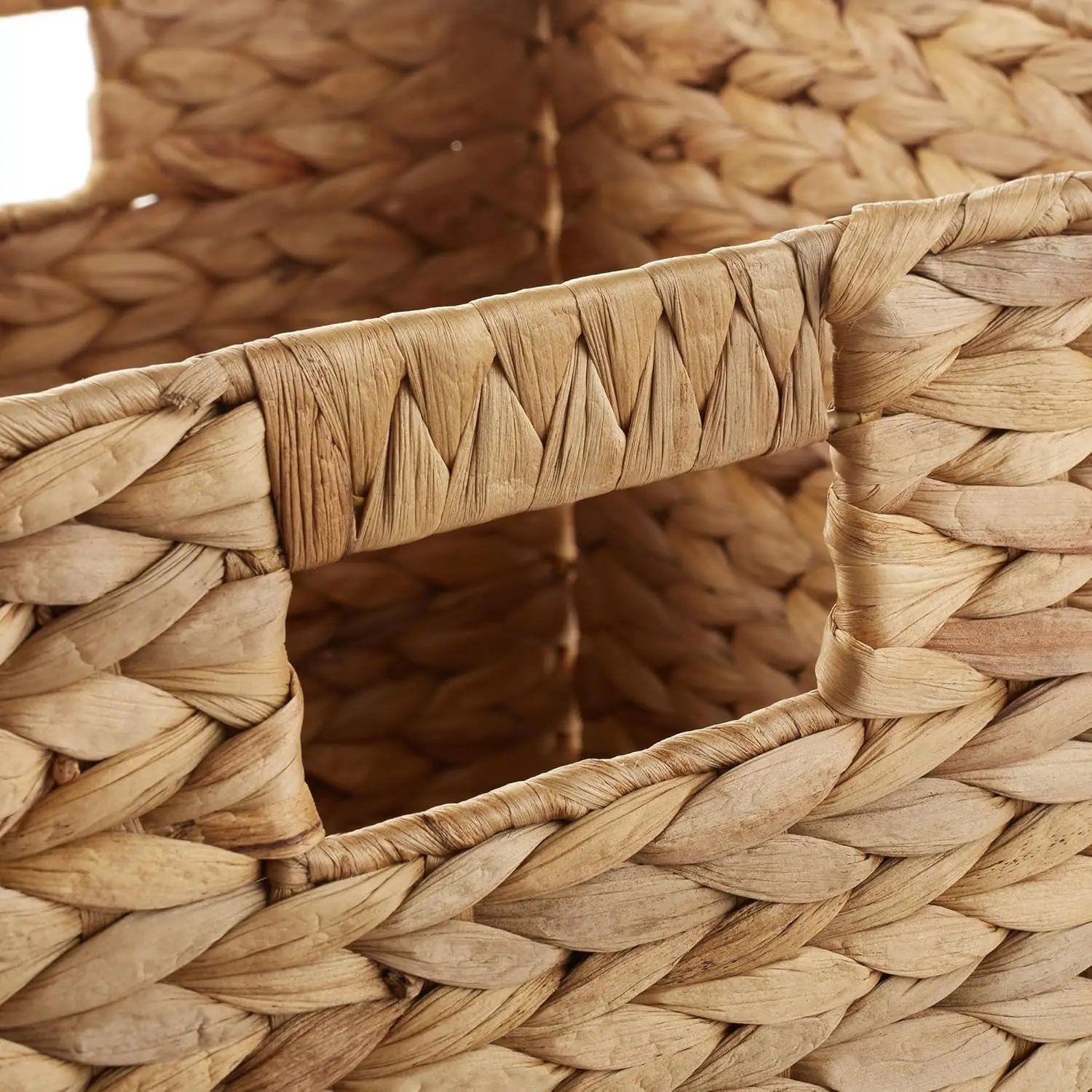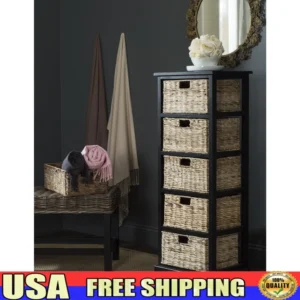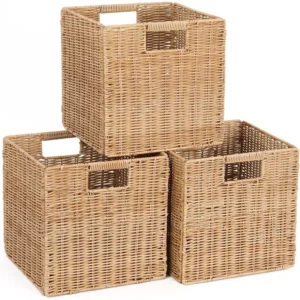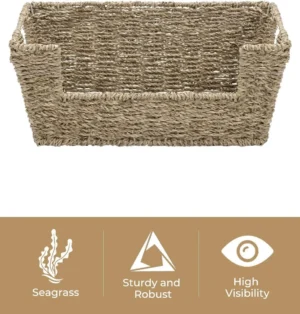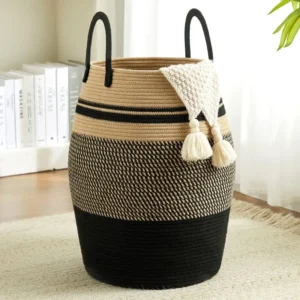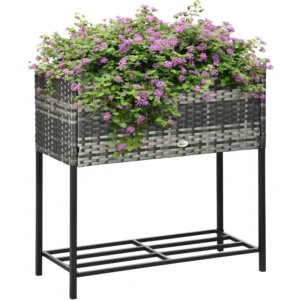The Power of Baskets for Shelf Organization and Decoration
Walking into a well-organized home feels different—calmer, more welcoming, and put-together. One of the simplest yet most effective ways to achieve this sense of order is through strategic basket placement on shelves. Baskets serve a dual purpose that few other storage solutions can match: they combine practical organization with beautiful design enhancement.
Many homeowners struggle with common challenges like limited space, visual clutter, and the need for accessible storage. Whether it’s toys scattered across living room shelves, bathroom products creating countertop chaos, or kitchen ingredients lost in pantry depths—baskets offer a versatile solution that works in every room.
The transformative effect of basket storage goes beyond simple tidiness. When thoughtfully selected and arranged, baskets can completely change the character of a room, adding warmth and texture while concealing everyday items that might otherwise create visual noise. They create cohesion across different spaces and allow you to quickly transform disorganized areas into styled vignettes.
Throughout this guide, we’ll explore how to select the perfect baskets for different spaces, organize various household items effectively, and style shelves that are both functional and beautiful. From organizing laundry with wicker baskets to creating decorative displays, you’ll discover how our premium wicker shelf baskets can revolutionize every room in your home.
Why Baskets Are Essential for Shelf Organization
Functional Benefits
Baskets excel at containment—corralling small items that would otherwise create visual noise and clutter across open shelving. Instead of seeing a jumble of remote controls, office supplies, or toiletries, you see a single, attractive basket that brings instant order to chaos.
The modular nature of basket storage creates remarkable flexibility. Unlike built-in solutions, baskets can be easily relocated as your needs change. Need to make space for new items? Simply move a basket to another shelf or room without any installation or renovation required.
Baskets also maximize vertical space on shelves that might otherwise go unused. By containing items that would typically spread out horizontally, baskets allow you to stack and organize upward, effectively doubling or tripling your available storage.
Perhaps most importantly, baskets establish clear organizational systems. By dedicating specific baskets to different categories of items—crafting supplies in one, electronic accessories in another—you create intuitive storage zones that make finding and returning items effortless.
Aesthetic Benefits
Beyond practical storage, baskets introduce appealing texture and warmth to spaces that might otherwise feel stark or clinical. Natural materials like rattan shelf baskets add organic elements that soften the hard lines of shelving units and built-ins.
Consistent basket usage creates visual cohesion across your shelving. Rather than a mismatched collection of containers or exposed items, coordinated baskets create a harmonious look that feels intentional and designed.
Baskets also enhance various design styles with remarkable versatility. In modern spaces, sleek, structured baskets with clean lines maintain minimalist appeal. In more rustic or coastal interiors, natural fiber baskets add appropriate texture and casual elegance. The right basket selection can bridge different design elements within a room.
With their ability to both solve organizational challenges and enhance your décor, baskets represent the perfect marriage of form and function. As you’ll discover throughout this guide, taming chaos by hiding clutter in baskets transforms not just your shelves but your entire living experience.
Perfect Basket Storage Ideas for Living Room Shelves
The living room presents unique storage challenges as it’s both a highly functional space and one where aesthetics matter tremendously. Shelves in this area often need to store practical items while maintaining a stylish, welcoming appearance.
For entertainment centers and media areas, consider these basket-worthy items:
– Remote controls and electronic accessories
– Gaming controllers and small accessories
– Media collections like DVDs or video games
– Power banks and charging cables
For bookcases and display shelves:
– Magazine and newspaper collections
– Throw blankets and small pillows
– Board games and card decks
– Seasonal decorative items
Living room basket styling works best when you combine both hidden and display storage. Use wicker baskets with lids for items that are best kept out of sight (like electronic accessories or children’s smaller toys), while using open baskets for items that add visual interest or that you access frequently.
When styling living room shelves, try alternating baskets with books, framed photos, and decorative objects for a balanced look. Position larger baskets on lower shelves for stability and visual weight, keeping smaller ones at eye level or above.
For families with children, designate specific baskets as “quick cleanup” solutions where toys can be rapidly gathered before guests arrive—maintaining the sophisticated appearance of your living space without eliminating the functionality families need.
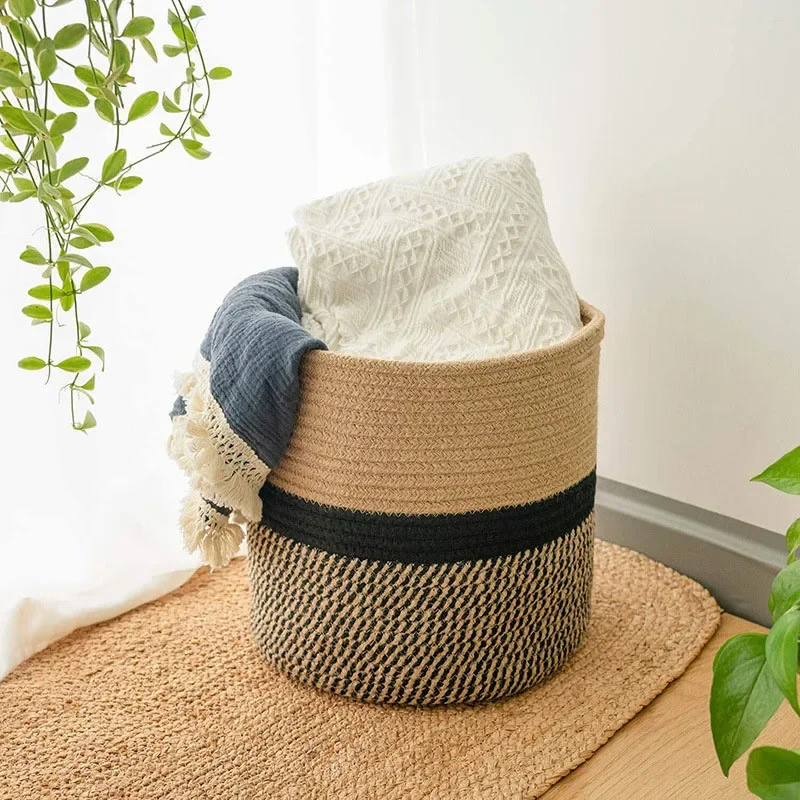
Kitchen and Pantry Shelf Organization with Baskets
Kitchen and pantry spaces require particularly thoughtful organization since they contain many small items that need to remain visible and accessible while maintaining order. Baskets transform chaotic shelves into functional zones that make cooking and meal preparation more enjoyable.
For pantry shelves, consider organizing these items in baskets:
– Packaged snacks grouped by type
– Baking supplies like chocolate chips, nuts, and dried fruits
– Tea collections and coffee accessories
– Spice jars and seasoning packets
– Root vegetables that don’t require refrigeration
For open kitchen shelving:
– Dish towels and cloths rolled neatly
– Frequently used utensils in upright containers
– Small appliance accessories (blender parts, food processor blades)
– Recipe cards and frequently referenced cookbooks
In kitchen environments, labeling becomes particularly important. Mastering the ultimate guide to labeling baskets ensures everyone in the household can maintain your organizational system. Consider waterproof labels for kitchens where splashes are common.
When selecting baskets for kitchen use, prioritize materials that can withstand occasional spills and are easy to wipe clean. For items like onions and potatoes, choose baskets with good airflow to prevent premature spoiling. Wire baskets with removable liners offer ideal ventilation while containing any debris.
Position your most frequently used items in baskets at eye level, with less common ingredients or seasonal items stored higher up or lower down. This hierarchy of accessibility makes daily kitchen tasks more efficient while maintaining beautiful shelf displays.
Bathroom Storage Solutions Using Shelf Baskets
Bathroom shelves present unique challenges due to limited space, humidity concerns, and the need to store many small items. Baskets create order in this high-traffic area while adding style to a functional space.
For open bathroom shelving, consider organizing:
– Hand towels and washcloths rolled in hotel-style displays
– Everyday toiletries grouped by family member or function
– Extra toilet paper and tissue boxes
– Sealed containers of bath salts or bombs
– Hair tools and accessories
For medicine cabinet or closed cabinet shelving:
– First aid supplies in a clearly marked basket
– Makeup items sorted by type (lips, eyes, face)
– Skincare products organized by routine step
– Medications in appropriate containers (away from children)
When selecting bathroom baskets, material considerations are crucial. Woven storage baskets in water-resistant materials like plastic, sealed rattan, or treated water hyacinth stand up best to bathroom humidity. For baskets storing wet items like recently used hair tools, consider options with liners that can be removed and laundered.
To create a spa-like atmosphere, coordinate basket colors with your bathroom color scheme. White or light-colored baskets create a clean, fresh appearance, while natural materials add warmth to sterile bathroom environments. For children’s bathrooms, consider bright colored baskets to make organization more engaging.
Small bathrooms benefit tremendously from vertical storage—use tall, narrow baskets to maximize limited floor space, and consider stacking smaller baskets to utilize wall height effectively.
Bedroom and Closet Organization with Strategic Basket Placement
Bedrooms benefit perhaps more than any other space from effective basket organization—creating both the functional storage needed for clothing and personal items and the calm, uncluttered atmosphere essential for restful sleep.
For bedroom shelves and nightstands:
– Reading materials and journals
– Sleep accessories (eye masks, earplugs)
– Charging stations for electronics
– Aromatherapy items or personal care products
– Small mementos or keepsake items
For closet and dresser organization:
– Folded accessories like scarves, hats, and gloves
– Rolled belts and ties
– Undergarments and socks
– Seasonal items like swimwear or winter accessories
– Rarely used specialty clothing items
One particularly effective bedroom strategy involves using top closet baskets for shelves to divide long shelving into more manageable sections. Rather than stacking sweaters or t-shirts in tall piles that inevitably topple over, use medium-sized baskets to create “drawer-like” compartments that keep folded clothing neat and accessible.
For nightstand organization, select smaller baskets that can corral items typically scattered across bedside surfaces—reading glasses, hand creams, sleep masks, and electronic devices. This creates a more peaceful visual environment that promotes better sleep habits.
In children’s bedrooms, use baskets at lower heights to encourage independence in organization. When children can easily reach their own storage containers, they’re more likely to participate in keeping their spaces tidy.
Home Office and Craft Room Shelf Organization
Home offices and craft spaces contain many small items that can quickly create visual chaos if not properly organized. Basket systems create order while keeping supplies visible and accessible for creative work.
For office shelving:
– Paper types sorted by use (printing paper, notepads, specialty paper)
– Office supplies grouped by function (writing tools, adhesives, clips)
– Cords and tech accessories
– Filing systems for current projects
– Reference materials and frequently used books
For craft room organization:
– Yarn and fabric collections
– Paper crafting supplies
– Art tools by medium (painting, drawing, sculpting)
– Ongoing projects kept intact between sessions
– Small embellishments and notions
In creative spaces, visibility often matters as much as organization. Consider open baskets or those with clear fronts for supplies you need to see at a glance. For smaller items that tend to get lost, wicker laundry basket storage ideas can be adapted with internal dividers to create compartments within larger baskets.
Color coding baskets by project type or craft medium creates an intuitive organizational system that enhances productivity. Try assigning specific colored baskets to different family members or project types for quick visual identification.
For supplies used in multiple areas, consider creating portable “project baskets” that can move from shelf to work surface and back again, keeping all necessary items for specific tasks together and self-contained.
Children’s Room and Playroom Basket Storage Ideas
Organizing children’s spaces presents unique challenges—items are often small, numerous, and frequently used. Strategic basket placement teaches organizational skills while making cleanup manageable for young helpers.
For children’s bedroom and playroom shelves:
– Building blocks and construction toys
– Collections of small toys (cars, figures, dolls)
– Art supplies divided by type
– Puzzles and games
– Stuffed animals and soft toys
Basket selection for children’s spaces should prioritize safety and ease of use. Small wicker baskets with smooth edges and lightweight construction allow children to participate in organization independently. For very young children, flexible fabric baskets eliminate concerns about hard corners.
Visual labeling systems work wonderfully for children of all ages. For pre-readers, attach photos or pictures of contents to basket fronts. Older children benefit from clear written labels that reinforce literacy while aiding organization.
One effective strategy for toy management is creating a rotation system using baskets. Store some toys in accessible baskets and others in storage areas, swapping them periodically to renew interest and prevent overwhelming toy clutter in play spaces.
Position most-used toy baskets on lower shelves where children can reach them independently, teaching responsibility for both getting items out and putting them away.
Entryway and Mudroom Shelf Organization with Baskets
Entryways set the tone for your entire home while managing the practical transition between outside and inside worlds. Baskets here must be both functional and attractive, containing the chaos that typically accumulates near doors.
For entryway and mudroom shelves:
– Seasonal accessories (gloves, hats, scarves)
– Individual family member baskets for personal items
– Pet supplies like leashes, waste bags, and small toys
– Mail sorting and bill payment systems
– Keys, sunglasses, and on-the-go essentials
Creating personalized basket systems works particularly well in shared entry spaces. Assign individual wicker baskets with handles to each family member for their specific items, reducing morning searches for essentials and clarifying responsibility for putting things away.
For entryway baskets, prioritize durability since these containers face heavy daily use. Structured baskets that maintain their shape even when frequently accessed work best for entries. Consider moisture-resistant materials for baskets that might hold damp items like umbrellas or snow-covered accessories.
Create seasonal rotation systems where off-season items move to storage while current-season accessories remain easily accessible. This prevents entryway overcrowding while ensuring needed items are always at hand.
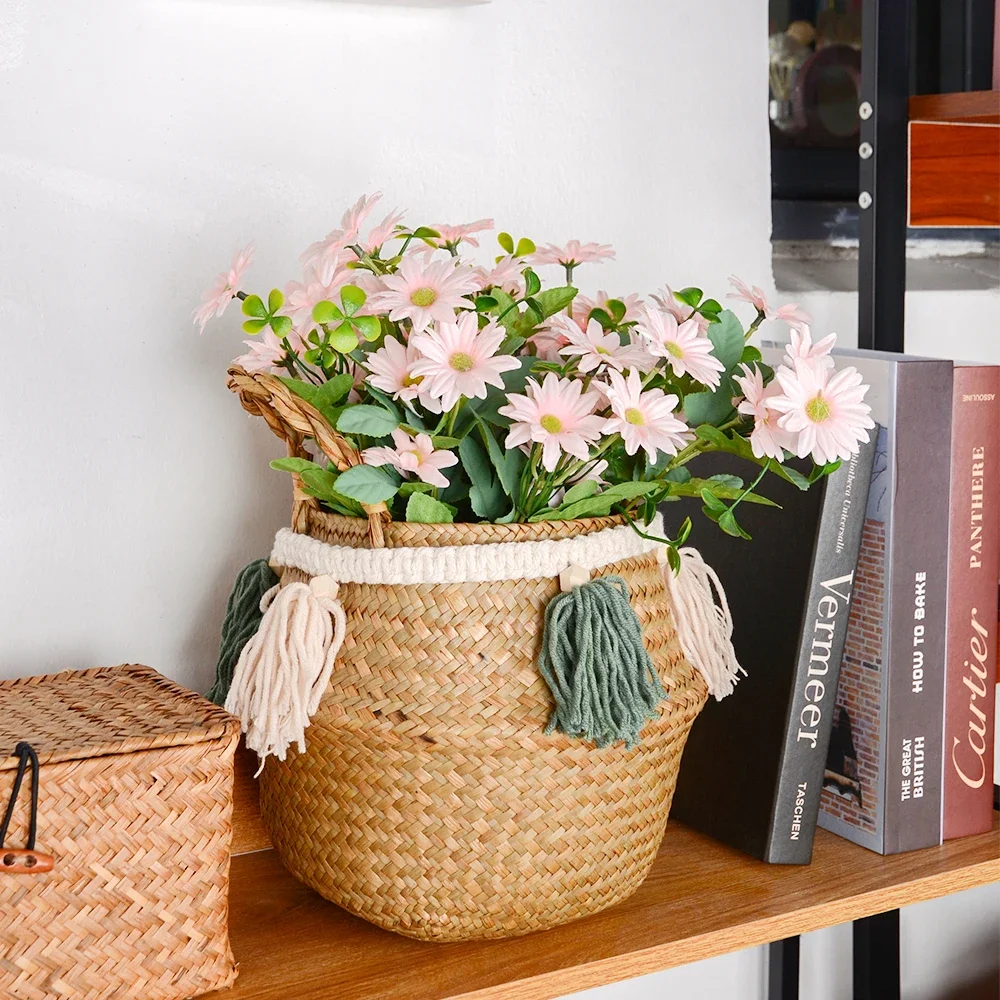
How to Select the Perfect Baskets for Your Shelves
Choosing the right baskets dramatically impacts both the functionality and appearance of your shelf organization. Consider these essential factors when making your selection:
Material Considerations:
– Natural fibers (rattan, seagrass, water hyacinth) add warmth and texture but may be less suitable for humid environments without proper treatment
– Metal or wire baskets offer excellent visibility and airflow for certain items
– Fabric baskets work well for soft items and children’s spaces
– Plastic or resin options provide maximum durability for high-moisture areas
Size and Fit:
Always measure your shelves before purchasing baskets, considering not just width and depth but also height clearance. The ideal basket should leave at least 1-2 inches of space above for easy removal without scraping knuckles or damaging shelves. Consider how items will fit within baskets—too deep, and small items get lost; too shallow, and items may not be properly contained.
Features to Consider:
– Handles make removal from shelves easier, especially for heavier items
– Lids conceal contents for a cleaner look and dust protection
– Dividers help organize smaller items within larger baskets
– Liners protect baskets from spills and extend lifespan
The basket’s purpose should guide your selection. For purely decorative applications, appearance might take precedence. For daily-use storage, prioritize durability and functionality. Understanding what you can store in a wicker basket helps determine the best structure and features for your needs.
For a cohesive look, consider how baskets will work with your overall décor. While they don’t need to match perfectly, complementary colors and materials create visual harmony across spaces.
Black Wicker Baskets, Rattan Storage Baskets, Tall Wicker Baskets, Wicker Shelf Baskets, Woven Storage Baskets
5-Tier Distressed Black Wood Frame Storage Tower with Removable Wicker Baskets for Home Organization$715.80 Select options This product has multiple variants. The options may be chosen on the product pageWicker Laundry Baskets, Woven Laundry Baskets, Woven Storage Baskets
$392.02 Select options This product has multiple variants. The options may be chosen on the product pageRattan Shelf Baskets, Rattan Storage Baskets, Small Wicker Baskets, Square Wicker Baskets
Square Plastic Wicker Storage Baskets Set of 3 with Collapsible Design for Cube Storage Organization$185.47 Select options This product has multiple variants. The options may be chosen on the product pageWicker Baskets with Handles, Wicker Storage Baskets, Woven Storage Baskets
$137.92 Select options This product has multiple variants. The options may be chosen on the product pageLarge Wicker Laundry Baskets, Tall Wicker Baskets, Woven Laundry Hampers, Woven Storage Baskets
$130.54 Select options This product has multiple variants. The options may be chosen on the product pageRattan Shelf Baskets, Rattan Storage Baskets
$345.47 Select options This product has multiple variants. The options may be chosen on the product page
Expert Styling Tips for Arranging Baskets on Shelves
Once you’ve selected your perfect baskets, thoughtful arrangement transforms functional storage into designed display. Professional stylists use these techniques to create balanced, appealing shelf compositions:
Apply the rule of odds: Group baskets in clusters of three or five rather than even numbers. This creates more dynamic, interesting arrangements than perfectly symmetrical groupings.
Create visual triangles: When arranging multiple baskets on a single shelf or across several shelves, imagine connecting them to form triangles. This technique naturally draws the eye across the display in a pleasing way.
Vary heights and depths: Alternate taller baskets with shorter ones, and occasionally place some baskets forward and others back on the shelf for dimensional interest. This layering creates a more sophisticated look than perfect alignment.
Balance visual weight: Distribute larger or darker-colored baskets throughout the shelving rather than clustering them together, which can make shelves appear lopsided.
Introduce complementary elements: Baskets look best when styled alongside other objects. Incorporate books, plants, framed photos, or decorative objects between basket groupings for a curated appearance.
Learning to properly style tall baskets in living spaces allows you to make dramatic statements with larger pieces while maintaining balance. For tall shelving units, place larger baskets on lower shelves for stability and visual grounding.
When styling open shelving, remember that negative space is just as important as filled space. Allow some breathing room around baskets rather than packing shelves completely full—this highlights your careful curation rather than suggesting overcrowding.
For mixed-material shelving, coordinate basket selection accordingly. Wood shelving pairs beautifully with natural fiber baskets, while metal or glass shelving might be complemented by more structured basket types.
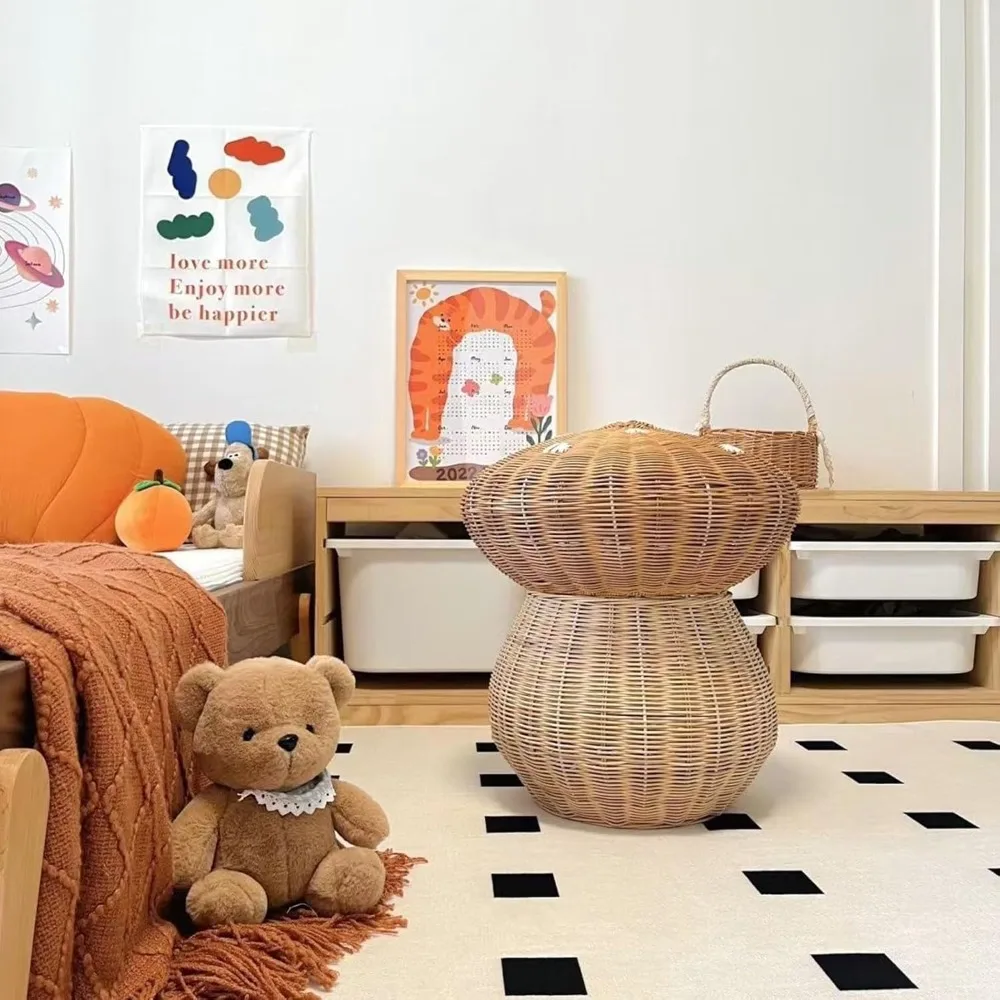
Decorative Uses: Beyond Storage Applications
Baskets offer more than practical storage—they can function as decorative elements in their own right. Consider these creative applications that highlight baskets as design features:
- Use shallow baskets as wall-mounted display frames for artwork or botanical specimens
- Create seasonal vignettes within larger baskets, changing contents to reflect holidays or seasons
- Display collections of smaller items (like vintage spools, decorative eggs, or small art pieces) in shallow open baskets
- Use baskets as planters for real or artificial greenery, adding natural elements to shelving
- Showcase particularly beautiful or unusual baskets empty as sculptural elements
Texture plays a crucial role in sophisticated interior design, and decorative wicker baskets for home style introduce this important element to shelving in an accessible way. Even in minimalist spaces, the organic texture of baskets adds warmth and visual interest.
For a cohesive look throughout changing seasons, select neutral baskets that can accommodate different decorative elements throughout the year. A simple seagrass basket might hold pine cones and evergreen sprigs in winter, flowering branches in spring, and coastal elements in summer.
Consider the silhouette baskets create against your wall color or backing. Dark baskets create dramatic contrast against light walls, while lighter baskets blend more seamlessly. Both approaches can be effective depending on whether you want your baskets to stand out as focal points or integrate harmoniously.
Must-Have Basket Accessories and Organizational Helpers
Enhance your basket organization system with these practical accessories that improve both function and appearance:
Basket liners: Protect baskets from spills and stains while adding color and pattern. Washable cotton liners are ideal for baskets containing children’s items or kitchen goods.
Dividers and inserts: Create compartments within larger baskets to prevent smaller items from becoming jumbled together. Adjustable dividers work particularly well for office supplies and craft materials.
Label systems: From elegant handwritten tags to modern printed labels, identification systems ensure everyone in the household can maintain your organization. Consider erasable options for baskets whose contents might change seasonally.
Basket feet or grippers: Protect both your baskets and shelving surfaces with small felt pads or silicone grippers that prevent sliding and scratching.
DIY enthusiasts can customize basic baskets with paint, fabric wrapping, or decorative trim to perfectly match their décor. Using techniques from DIY laundry organization with wicker baskets can transform simple containers into custom storage pieces.
For items that need additional protection, consider using smaller containers within your display baskets—like glass jars for bathroom cotton balls or small fabric pouches for jewelry and accessories. This creates a “container within a container” system that maximizes organization while maintaining a cohesive look.
How to Maintain and Clean Your Shelf Baskets
Proper care extends the life of your basket collection and keeps your organizational system looking fresh. Different materials require specific approaches:
Natural Fiber Baskets (Rattan, Seagrass, Water Hyacinth):
– Dust regularly with a soft cloth or vacuum with brush attachment
– Spot clean spills immediately with a barely damp cloth
– Avoid direct sunlight which can fade and weaken natural fibers
– Occasionally air outside on dry days to prevent mustiness
Fabric Baskets:
– Check manufacturer instructions for washing recommendations
– Use fabric protectant on new baskets to prevent staining
– Reshape while damp if washing is necessary
– Allow to dry completely before refilling
Plastic and Synthetic Baskets:
– Wash with mild soap and water as needed
– Disinfect occasionally, especially in bathroom or kitchen environments
– Check for cracking or wear and replace when structural integrity is compromised
When baskets are not in use, proper storage of baskets not in use prevents warping and damage. Stack similar sizes together when possible, with tissue paper between to prevent scratching. Store in climate-controlled areas to prevent mildew growth on natural fibers.
For baskets in high-humidity environments like bathrooms, consider regular inspection for early signs of mold or mildew. Catching these issues early prevents permanent damage and extends basket lifespan.
Elevating Your Shelves with Coordinated Basket Systems: The Tidy Treasure Approach
Creating a truly sophisticated organization system often involves moving beyond mismatched containers to thoughtfully coordinated collections. The Tidy Treasure approach emphasizes quality, coordination, and intentional selection.
Quality baskets represent an investment in your home’s organization and appearance. Superior construction means tighter, more consistent weaving, sturdier handles that won’t break under regular use, and materials selected for both beauty and durability. While higher-quality baskets may cost more initially, their extended lifespan and enhanced appearance provide greater value over time.
Coordinated basket systems create visual harmony while accommodating different storage needs. Rather than exact matching, consider complementary collections—baskets that share material, color family, or weaving style while offering different sizes and configurations. This approach creates cohesion without monotony across different rooms and storage needs.
The sustainability aspect of premium baskets shouldn’t be overlooked. High-quality natural fiber baskets often represent traditional craftsmanship and sustainable harvesting practices. By investing in fewer, better baskets rather than disposable organization solutions, you’re making an environmentally conscious choice while elevating your home’s appearance.
For those seeking to create a cohesive look throughout their home, exploring options for where to buy matching home storage provides guidance on building collections that work beautifully together while meeting diverse organizational needs.
Frequently Asked Questions About Shelf Basket Organization
Q: How can I prevent baskets from sliding on smooth shelves?
A: Consider non-slip shelf liners cut to size beneath baskets, small adhesive rubber bumpers at basket corners, or discrete dots of removable museum putty for valuable or delicate baskets.
Q: Is it better to use many small baskets or fewer large ones?
A: This depends on your items and access needs. Small baskets work better for diverse categories that you want to keep separate. Larger baskets are ideal for bulkier items or collections you typically access all at once. Many organizers find a combination most effective.
Q: How can I keep basket contents visible but still neat?
A: Consider open-weave baskets that allow partial visibility, baskets with cut-out handles that provide a glimpse inside, or labeled baskets that clearly identify contents without exposing them. For maximum visibility with organization, use clear dividers inside open baskets.
Q: Will heavy items damage my baskets over time?
A: Yes, baskets can stretch or warp under excessive weight. For heavy items, choose structured baskets with reinforced bottoms and handles, or consider distributing weight among several smaller baskets rather than overloading one large basket.
Q: How often should I reorganize my basket systems?
A: Most organizers benefit from seasonal reassessment (4 times yearly) plus mini-evaluations whenever basket contents start to overflow or no longer serve current needs. Regular maintenance prevents major organizational breakdowns and keeps your system functioning optimally.
With these guidelines, techniques, and ideas, you’re well-equipped to transform every room in your home with beautiful and functional basket organization. Remember that the best systems grow and adapt with your changing needs while maintaining the aesthetic appeal that makes your house feel like a home.

